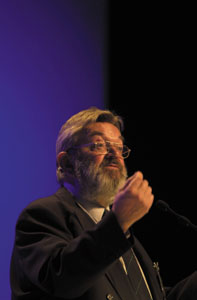As the era of CERN’s LEP electron-positron collider draws to a close, that of CERN’s next major machine – the LHC proton collider – is set to begin. A special celebration event at CERN marked this major milestone in the laboratory’s history.

On 9 October, CERN revelled in the kind of festival of pomp and protocol that only large international organizations can enjoy. In a proud display on a scale not seen at the laboratory since the official inauguration of the LEP electron-positron collider in November 1989, VIP representatives, including Swiss President Adolf Ogi, came from all 20 CERN Member States, and from countries further afield participating in CERN’s research programme, together with local dignitaries. They converged on a soccer-pitch sized experimental hall specially converted into an indoor amphitheatre and exhibition area.
The occasion – the LEP celebration – marked the end of the era of CERN’s LEP electron-positron collider – more than 20 years of detailed preparation, planning and construction, including 11 years of operation which changed the face of physics. LEP is scheduled to be dismantled soon so that its 27 km tunnel can become the home for the ambitious LHC proton collider, which is due to come into operation in 2005.
LEP was supposed to be switched off in September to allow LHC construction proper to get underway, but tentative glimpses of new physics results motivated additional LEP running. The carefully collected new data have yet to reveal all their secrets.
The possibility is that the LEP experiments might have caught a glimpse of the long-awaited Higgs particle, which breaks electroweak symmetry and pervades the whole of space to endow particles with mass.
On the day


After the proceedings were opened by CERN director-general Luciano Maiani, 1999 Nobel laureate Martin Veltman summarized the state of our knowledge of the world of elementary particles.
“It happens that the theory and the data found by LEP allow us to guess properties of the Higgs particle. On the basis of that, we have a reasonable hope that it may be seen with the LHC, the machine that will take the place of LEP,” maintained Veltman.
“This is by no means sure, but there is reasonable hope. It may in fact just be within reach of LEP, that by means of an unbelievable tour de force of the CERN engineering staff has been upgraded substantially. However, seeing it is one thing, studying it is another matter.
“Thus, to us, this extremely strange Higgs force may be the door to understanding other mysteries of particle physics. No one can even guess what there is. It may be utterly strange. It may have enormous consequences for our understanding of this world, including the structure of the whole universe. We must know. The LHC may well be the key to this knowledge.”
Opening the galaxy of speeches from high-level government representatives was an ebullient Adolf Ogi, President of the Swiss Confederation. “CERN is shaping the scientific future of our continent,” he said.
Ministerial speeches came in turn from French Minister of Research Roger-Gérard Schwartzenberg, German Minister of Education and Research Edelgard Bulmahn, UK Science Minister Lord Sainsbury, Italian Minister for Universities, Science and Technology Ortensio Zecchino, Spanish Minister of Science and Technology Anna Birules, Polish Minister of Science Andrzej Wiszniewski, Slovak Deputy Prime Minister Lubomir Fogas, Bulgarian Minister of Education and Science Dimitar Dimitrov, Portuguese Minister of Science and Technology Mariano Gago, and European Commissioner for Research Philippe Busquin.
“CERN is a convincing demonstration of the level of excellence which Europeans can achieve when they combine their forces. Its example should encourage us to pursue these efforts as far and for as long as necessary,” said Commissioner Busquin.
CERN Member States Austria, Belgium, the Czech Republic, Denmark, Finland, Greece, Hungary, Norway, the Netherlands and Sweden were also represented.
For CERN Observer States and other countries participating in the CERN research programme were Russian First Minister for Science Mikhail Kirpichnikov, Turkish State Minister Edip Safter Gaydali, John O’Fallon of the US Department of Energy, Director of Monbusho (Japan) International Scientific Affairs Keisuke Yoshio, and Indian Ambassador Savitri Kunadi. Following the speeches, delegates formally unveiled a commemorative plaque (see “LEP commemorative plaque” below).
Ballet


Especially memorable was a ballet performance by the Rudra-Béjart Ballet School, Lausanne, for which pupils from all over the world are selected by Maurice Béjart himself. The elements of the show were prepared by School Director Michel Gascard, while Béjart mounted the ballet and integrated its separate elements.
The area adjoining the indoor theatre/auditorium housed a specially-mounted exhibition of CERN’s proud achievements – the World Wide Web, LEP’s physics accomplishments, and some examples of the technology and construction for major experiments.
After the show, the amphitheatre was taken over for a two-day science symposium covering the inception and construction of LEP and its experiments, and the science and developments that have emerged.

LEP commemorative plaque
“We, the Participating Countries, recognize the outstanding scientific achievements of LEP that have illuminated the family structure of fundamental particles and the texture of our universe.
“LEP has stimulated new ideas and technologies with applications reaching far beyond the realms of fundamental physics – best known in the World Wide Web.
“LEP has set new standards for international scientific collaboration, giving scientists from all over the world the opportunity to work together and push back the limits of the unknown. Worldwide contacts and relations have been established by using the new instruments and techniques developed at CERN and by the particle physics community.
“LEP achievements open the way for a new challenge, the Large Hadron Collider (LHC), which will allow us to go deeper in the exploration of the structure of matter, space and time.
“The LHC goes beyond international collaboration towards true global partnership in science. This partnership is enhanced by technical excellence and improved communications networks.
“CERN shall remain at the forefront of science as a world-class laboratory to broaden our knowledge and train young generations of scientists. CERN shall continue its role as a vehicle for innovation to improve the quality of life and mutual understanding among people.
“We congratulate CERN and its partners on their exciting achievements with LEP. Now the baton is passed to the LHC. We look forward to launching soon the new scientific programme that will lead to more far-reaching discoveries.”





